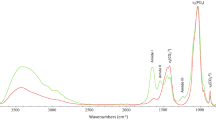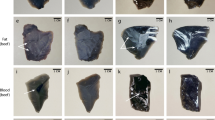Abstract
Raman spectroscopy was used to study trends in chemical composition of bones in a burial environment. A turkey bone was sectioned and buried for short intervals between 12 and 62 days. Buried sections were analyzed using Raman microspectroscopy with 785 nm excitation. The results indicate that chemical changes in bone due to soil bacteria are time-dependent. Spectroscopic trends within buried bone segments were correlated to burial duration. A preliminary model was constructed using peak integration of Raman bands. Data collected within buried bone segments fit very well in this model. The model constructed is sensitive to changes in bone composition in a scale of days. This study illustrates the great potential of Raman spectroscopy as a non-destructive method for estimating the burial duration of bone for forensic purposes.







Similar content being viewed by others
References
Brettell TA, Butler JM, Almirall JR (2009) Forensic Science. Anal Chem 81(12):4695–4711
Boddington A, Garland AN (1987) Death, decay and reconstruction: approaches to archaeology and forensic science. Manchester University, Manchester
Houck M, Seiegel J (2006) Fundamentals of forensic science. Elsevier Limited, Burlington
Reeves NM (2009) Taphonomic effects of vulture scavenging. J Forensic Sci 54(3):523–528
Nagy G, Lorand T, Patonai Z, Montsko G, Bajnoczky I, Marcsik A, Mark L (2008) Analysis of pathological and non-pathological human skeletal remains by FT-IR spectroscopy. Forensic Sci Int 175(1):55–60
Quickenden TI, Cooper PD (2001) Increasing the specificity of the forensic luminol test for blood. Luminescence 16(3):251–253
Introna F, Di Vella G, Campobasso CP (1999) Determination of postmortem interval from old skeletal remains by image analysis of luminol test results. J Forensic Sci 44(3):535–538
Ramsthaler F, Kreutz K, Zipp K, Verhoff MA (2009) Dating skeletal remains with luminol-chemiluminescence. Validity, intra- and interobserver error. Forensic Sci Int 187(1–3):47–50
Swift B (1998) Dating human skeletal remains: investigating the viability of measuring the equilibrium between Po-210 and Pb-210 as a means of estimating the post-mortem interval. Forensic Sci Int 98(1–2):119–126
Wild EM, Arlamovsky KA, Golser R, Kutschera W, Priller A, Puchegger S, Rom W, Steier P, Vycudilik W (2000) 14C dating with the bomb peak: an application to forensic medicine. Nucl Instrum Methods Phys Res Sect B Beam Interact Mater Atoms 172(1–4):944–950
Middleton J (1845) On fluorine in bones, its source, and its application to the determination of the geological age of fossil bones. Q J Geol Soc 1(1):214–216
Johnsson K (1997) Chemical dating of bones based on diagenetic changes in bone apatite. J Archaeol Sci 24(5):431–437
Leitnerwild E, Steffan I (1993) Uranium-series dating of fossil bones from Alpine caves. Archaeometry 35:137–146
Schwarcz HP, Agur K, Jantz LM (2010) A new method for determination of postmortem interval: citrate content of bone. J Forensic Sci 55:1516–1522
Bertoluzza A, Brasili P, Castri L, Facchini F, Fagnano C, Tinti A (1997) Preliminary results in dating human skeletal remains by Raman spectroscopy. J Raman Spectrosc 28(2–3):185–188
Buckwalter JA, Glimcher MJ, Cooper RR, Recker R (1995) Bone biology. 1. Structure, blood-supply, cells, matrix, and mineralization. J Bone Jt Surg Am 77A(8):1256–1275
Vitagliano L, Nemethy G, Zagari A, Scheraga HA (1993) Stabilization of the triple-helical structure of natural collagen by side-chain interactions. Biochemistry 32(29):7354–7359
Bhatnagar RS, Pattabiraman N, Sorensen KR, Langridge R, Macelroy RD, Renugopalakrishnan V (1988) Inter-chain proline–proline contacts contribute to the stability of the triple helical conformation. J Biomol Struct Dyn 6(2):223
Lazarev YA, Grishkovsky BA, Khromova TB, Lazareva AV, Grechishko VS (1992) Bound water in the collagen-like triple-helical structure. Biopolymers 32(2):189–195
Lazarev YA, Grishkovsky BA, Khromova TB (1985) Amide-I band of Ir-spectrum and structure of collagen and related polypeptides. Biopolymers 24(8):1449–1478
Lazarev YA, Lazareva AV, Shibnev A, Esipova NG (1978) Infrared-spectra and structure of synthetic polytripeptides. Biopolymers 17(5):1197–1214
Pfretzschner HU (2006) Collagen gelatinization: the key to understand early bone-diagenesis. Palaeontogr Abt A 278(1–6):135
Hedges REM (2002) Bone diagenesis: an overview of processes. Archaeometry 44:319–328
Collins MJ, Riley MS, Child AM, Turnerwalker G (1995) A basic mathematical simulation of the chemical degradation of ancient collagen. J Archaeol Sci 22(2):175–183
Turban-Just S (1997) Biogenic decomposition of bone collagens. Anthropologischer Anzeiger; Bericht uber die biologisch-anthropologische Literatur 55(2):131–141
Virkler K, Lednev IK (2009) Raman spectroscopic signature of semen and its potential application to forensic body fluid identification. Forensic Sci Int 193(1–3):56–62
Virkler K, Lednev IK (2009) Blood species identification for forensic purposes using Raman spectroscopy combined with advanced statistical analysis. Anal Chem 81(18):7773–7777
Virkler K, Lednev IK (2010) Forensic body fluid identification: the Raman spectroscopic signature of saliva. Analyst 135(3):512–517
Virkler K, Lednev IK (2010) Raman spectroscopic signature of blood and its potential application to forensic body fluid identification. Anal Bioanal Chem 396(1):525–534
Sikirzhytski V, Virkler K, Lednev IK (2010) Discriminant analysis of Raman spectra for body fluid identification for forensic purposes. Sensors 10(4):2869–2884
Stich S, Bard D, Gros L, Wenz HW, Yarwood J, Williams K (1998) Raman microscopic identification of gunshot residues. J Raman Spectrosc 29(9):787–790
Hodges CM, Akhavan J (1990) The use of Fourier-transform Raman-spectroscopy in the forensic identification of illicit drugs and explosives. Spectroc Acta Pt A Molec Biomolec Spectr 46(2):303–307
Carver FWS, Sinclair TJ (1983) Spectroscopic studies of explosives. 1. Detection of nitro-compounds on silica-gel and carbon by non-resonant Raman-spectroscopy. J Raman Spectrosc 14(6):410–414
Lewis IR, Daniel NW, Chaffin NC, Griffiths PR, Tungol MW (1995) Raman spectroscopic studies of explosive materials: towards a fieldable explosives detector. Spectroc Acta Pt A Molec Biomolec Spectr 51(12):1985–2000
Sands HS, Hayward IP, Kirkbride TE, Bennett R, Lacey RJ, Batchelder DN (1998) UV-excited resonance Raman spectroscopy of narcotics and explosives. J Forensic Sci 43(3):509–513
Wolfe J, Exline DL (2003) Characterization of condom lubricant components using Raman spectroscopy and Raman chemical imaging. J Forensic Sci 48(5):1065–1074
Coyle T, Anwar N (2009) A novel approach to condom lubricant analysis: in-situ analysis of swabs by FT-Raman spectroscopy and its effects on DNA analysis. Sci Justice 49(1):32–40
Nafie LA (2001) Theory of Raman scattering. In: Lewis IR, Edwards HGM (eds) Handbook of Raman spectroscopy: from the research laboratory to the process line. Marcel Dekker, Inc., New York
Freeman JJ, Silva MJ (2002) Separation of the Raman spectral signatures of bioapatite and collagen in compact mouse bone bleached with hydrogen peroxide. Appl Spectrosc 56(6):770–775
Penel G, Leroy G, Bres E (1998) New preparation method of bone samples for Raman microspectrometry. Appl Spectrosc 52(2):312–313
Le Blond S, Guilminot E, Lemoine G, Huet N, Mevellec JY (2009) FT-Raman spectroscopy: a positive means of evaluating the impact of whale bone preservation treatment. Vib Spectrosc 51(2):156–161
Prystupa DA, Donald AM (1996) Infrared study of gelatin conformations in the gel and sol states. Polym Gels Netw 4(2):87–110
Nielsen-Marsh CM, Hedges REM, Mann T, Collins MJ (2000) A preliminary investigation of the application of differential scanning calorimetry to the study of collagen degradation in archaeological bone. Thermochim Acta 365(1–2):129–139
Wang Y, Purrello R, Jordan T, Spiro TG (1991) UVRR spectroscopy of the peptide-bond. 1. Amide-S, a nonhelical structure marker, is a C-alpha-H bending mode. J Am Chem Soc 113(17):6359–6368
Austin JC, Jordan T, Spiro TG (1993) Ultraviolet resonance Raman studies of proteins and related model compounds. Biomol Spectrosc 20A:55–127
Wojtuszewski K, Mukerji I (2004) The HU-DNA binding interaction probed with UV resonance Raman spectroscopy: structural elements of specificity. Protein Sci 13(9):2416–2428
Evershed RP, Dudd SN, Charters S, Mottram H, Stott AW, Raven A, van Bergen PF, Bland HA (1999) Lipids as carriers of anthropogenic signals from prehistory. Philos Trans R Soc Lond Ser B Biol Sci 354(1379):19–31
Acknowledgments
We would like to thank the University at Albany benevolence fund for providing financial support for this research project and Aliaksandra Sikirzhytskaya for designing the online abstract figure.
Author information
Authors and Affiliations
Corresponding author
Electronic supplementary material
Rights and permissions
About this article
Cite this article
McLaughlin, G., Lednev, I.K. Potential application of Raman spectroscopy for determining burial duration of skeletal remains. Anal Bioanal Chem 401, 2511–2518 (2011). https://doi.org/10.1007/s00216-011-5338-z
Received:
Revised:
Accepted:
Published:
Issue Date:
DOI: https://doi.org/10.1007/s00216-011-5338-z




